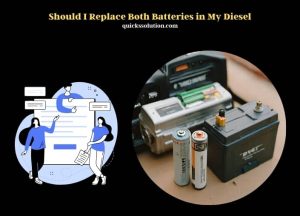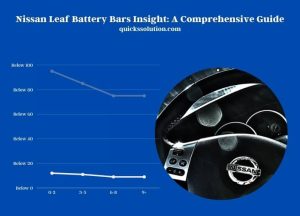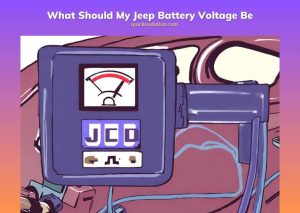Published on: August 14, 2023
Written by Amlan Roy / Fact-checked by Hashim Manna
The oil and battery light coming on in a car, along with the vehicle not starting, usually indicates a problem with the electrical system or engine. If the alternator isn’t charging the battery properly, it could be the reason for the battery light. The oil light could be related but might require further investigation, such as replacing the alternator first.
Now, let’s get into some details. Your ignition might be faulty, which means the car’s engine is not receiving the necessary electrical signal to start. Or it could be a starter problem, where the motor responsible for cranking the engine fails.

The alternator plays a vital role in keeping your battery charged, and if it’s not working correctly, you’ll see the battery light on your dashboard. Many vehicles will show a check engine light if there’s a charging system failure. That’s why it’s a good idea to get it checked out right away. The oil light could also be related, but figuring that out might be a little more complex, and fixing the alternator might be the first step.
Fuel issues or engine malfunctions could also be the culprit. Running diagnostics is often the best way to pinpoint the exact problem. With modern cars, a professional mechanic can hook up a diagnostic tool and quickly find the root of the problem.
Want to know more? Read the detailed article below, and you’ll learn all about the various elements that can cause these lights to come on, like the ignition, starter, alternator, electrical system, fuel, battery, engine, oil-pressure, diagnostics, and malfunction. It’s essential to get to the bottom of this issue to keep your car running smoothly!
Identifying the Problem with Dashboard Lights
Recognizing the Oil Light
You know that little red or yellow oil can icon on your dashboard? When it lights up, it’s trying to tell you something’s wrong with the oil pressure. It might be low oil level or even a failing oil pump. Don’t ignore it; your engine relies on oil to run smoothly!
Recognizing the Battery Light
A battery symbol on your dashboard usually means there’s an issue with the charging system. It could be a dying battery, faulty alternator, or even a wiring problem. If this light stays on while you’re driving, it’s time to get it checked out before you’re stranded on the road.
Linking Symptoms to Potential Causes
So the oil and battery light on your car won’t start? It could be a simple fix or something more serious. Sometimes it’s a domino effect where one problem leads to another. We’ll walk you through each possibility to help you get back on the road!
The Role of the Alternator
How the Alternator Functions
Ever wonder how your car’s battery stays charged while driving? That’s the job of the alternator. It turns mechanical energy into electrical energy to power your vehicle’s electrical system and keep the battery charged. Like a heart pumping blood, it keeps everything running!
Symptoms of Alternator Failure
A squealing noise, dimming lights, or even a smell of burning rubber could mean your alternator is failing. These signs might be subtle at first but can quickly lead to a breakdown. Want to avoid a towing bill? Keep an eye (and ear) on these symptoms.
Common Alternator Problems and Solutions
| Problem | Solution |
| Loose Belt | Tighten or replace the belt |
| Faulty Bearings | Replace the bearings |
| Damaged Diodes | Replace the alternator |
| Bad Voltage Regulator | Replace the voltage regulator |
Battery Issues Explained
Assessing Battery Health
Your car’s battery is like its lifeline. But how do you know if it’s healthy? Watch for slow cranking when starting, dimming lights, or frequent need for jumps. Also, check for corrosion around the terminals. A simple voltage test can tell you a lot, too.
Recharging vs. Replacing the Battery
So you’ve found the battery’s not holding charge. Now what? Sometimes recharging can bring it back to life. But if it’s old or damaged, replacement might be the only way. Think of it like a rechargeable toothbrush; at some point, it just doesn’t hold charge anymore.
Battery Maintenance Tips
| Tip | Why It’s Important |
| Clean terminals | Prevents corrosion and improves connection |
| Check water level | Ensures proper battery function |
| Tighten connections | Prevents power loss |
| Regular inspection | Catches problems early |
Oil Pressure Concerns
Why Oil Pressure Matters
Oil pressure in a car is like blood pressure in our bodies. Too high or too low, and there are problems. Low oil pressure can lead to engine damage, while high oil pressure might indicate a blockage in the oil delivery system. Either way, that light is your early warning system.
Oil Pressure Sensors and Switches
Your car has sensors and switches that monitor oil pressure. If there’s an issue, they’ll let you know by lighting up that dashboard warning. But remember, they can fail too, giving false alarms or missing a real problem. It’s always good to double-check with a mechanic.
Types of Oil Pressure Problems
| Problem | Possible Causes |
| Low Oil Pressure | Leaks, worn pump, too thin oil |
| High Oil Pressure | Blockage, wrong oil type, faulty relief valve |
Electrical System Overview
Wires, Fuses, and Connections
Think of your car’s electrical system as a spider web of wires, fuses, and connections. A break or weak link anywhere, and things can go haywire. It might start with flickering lights and end with a car that won’t start. Regular checks can keep those spiders at bay!
The Interaction between Battery and Alternator
Imagine a dance between the battery and alternator. The battery starts the car, and the alternator keeps it going. If one stumbles, the other suffers. It’s a partnership that needs to be in sync for your car to run smoothly.
Diagnosing Electrical Failures
Diagnosing electrical issues can be like finding a needle in a haystack. It might be a blown fuse, corroded wire, or a loose connection. Special tools and a keen eye can help you find the problem, or sometimes, it’s best to let a professional handle it.
Examining the Ignition System
Ignition Switches
The ignition switch is like the starting gun for a race. Turn the key, and it signals the starter motor to run. If it’s faulty, the race never begins. Symptoms might include stalling, difficulty turning the key, or failure to start at all.
Spark Plugs and Coils
Spark plugs are like tiny lightning bolts igniting the fuel in your engine. If they or their coils fail, you’ll notice a drop in power, economy, or even failure to start. Like changing a light bulb, they need regular replacement to keep your car shining bright.
Common Symptoms of Ignition Failure
- Difficulty starting the vehicle
- Unexplained stalling
- Reduced fuel efficiency
- Engine misfiring
The Importance of the Starter Motor
What the Starter Does
The starter motor is like the push you give to a child on a swing. It gets the engine moving until it can run on its own. If it fails, your engine won’t start, no matter how hard you turn the key.
Symptoms and Diagnosis of Starter Problems
Clicking sounds when you turn the key? It might be the starter motor. But don’t jump to conclusions. Sometimes it’s the battery or even a bad connection. Proper diagnosis saves time and money, kind of like going to the doctor with a mystery ailment.
Fuel System Fundamentals

Fuel Pumps and Injectors
Imagine the fuel pump as your car’s heart, pumping fuel like blood to the engine. If it fails, the engine starves. Injectors are like the veins delivering it. Keeping them clean and functioning ensures a healthy, efficient engine.
Symptoms of Fuel System Malfunction
If your car’s acting like it’s running out of steam, it might be a fuel system problem. It could be stuttering, stalling, or even failing to start. Just like you wouldn’t run a marathon on an empty stomach, your car can’t run without proper fuel delivery.
Engine Malfunction Possibilities
Overheating and Leaks
Your engine getting too hot or leaking fluids is a serious issue. Think of it like a fever in a human body. It’s a sign something’s wrong. Whether it’s a failed thermostat, a leaky gasket, or something more serious, it’s something that needs immediate attention.
Engine Wear and Tear
Engines wear out, just like your favorite pair of jeans. Unlike jeans, though, you can’t patch them up with a sewing kit. Regular maintenance, proper lubrication, and timely repairs can keep your engine purring for years.
Professional Diagnostics and Repair
Finding a Trusted Mechanic
Finding a great mechanic is like finding a great barber or hairstylist. Once you find one, you stick with them! Look for certifications, ask for references, and pay attention to how they treat you and your car. Trust your gut; it usually knows what’s up!
Diagnostic Tools and Techniques
Mechanics have a toolbox filled with gadgets and gizmos to find out what’s wrong with your car. It’s like taking your car to the doctor for a check-up. These tools can pinpoint problems quickly and accurately, saving you time and money.
DIY Solutions and Maintenance Tips
Tools Required for Home Repairs
Ready to play mechanic at home? You’ll need more than a wrench and some elbow grease. From screwdrivers to scanners, having the right tools is like having the right ingredients for a recipe. It makes the job easier and the results better.
Safety Precautions and Tips
Working on a car is not child’s play. It can be dangerous if you’re not careful. Always follow safety guidelines, use proper tools, and don’t be afraid to ask for help. Think of it like handling sharp knives in the kitchen – caution is key!
Frequently Asked Questions
Oil and Battery Light on With Ignition Off
If the oil and battery warning lights remain illuminated on your vehicle’s dashboard even when the ignition is off, this is not typical behavior. These lights should only be on when the ignition is in the “on” position to indicate that the engine’s self-test is running. If they remain on after the ignition is turned off, it could be due to several issues:
- Electrical Issues: There might be a problem with your vehicle’s electrical system. A short circuit or a faulty ignition switch could cause the lights to stay on.
- Battery Problems: A weak or failing battery might not be able to power down the vehicle’s systems completely.
- Instrument Cluster Fault: The instrument cluster where these lights are displayed might have a malfunction causing it to not shut off properly.
- ECU (Engine Control Unit) Issues: The car’s computer might be experiencing problems, causing it to send incorrect signals to the dashboard.
- Alternator Problems: If the alternator is not charging the battery properly, it could lead to electrical anomalies, such as lights staying on when they shouldn’t.
It’s important to address this issue promptly, as it can lead to battery drain and potential damage to the vehicle’s electrical system. Here are some steps you can take:
- Check the Ignition: Make sure the ignition is fully turned off and the key is removed. Sometimes the ignition cylinder might not return to the “off” position completely.
- Inspect the Battery: Look at the battery terminals to ensure they are clean and secure. A poor connection can sometimes cause electrical issues.
- Consult the Manual: Refer to your vehicle’s owner’s manual for specific information regarding warning lights and troubleshooting steps.
- Seek Professional Help: If the problem persists, it’s advisable to have a professional mechanic or an auto electrician diagnose and fix the issue.
Could a Faulty Coil Pack Cause the Oil and Battery Light to Come On and Prevent the Car from Starting?
Yes, a faulty coil pack could cause the oil and battery light to come on and prevent the car from starting. If you’re experiencing these issues, it’s important to consider checking and replacing the coil pack with toprated coil packs to ensure proper functioning of your vehicle.
What Can Cause the Oil Light and Battery Light to Turn On in a Ford Focus?
This could be indicative of an oil pressure issue and a charging system problem. It’s wise to have your vehicle inspected by a professional. The oil issue might involve a leak or a failing pump, while the battery problem might be linked to the alternator or a worn-out battery.
Why Does the Ford Battery Light Stay On?
If the battery light stays on in your Ford, it might mean that the charging system has a problem. The issue could be as simple as a loose belt or as serious as a failing alternator. It’s best to consult a professional to pinpoint the cause.
Are Low Oil Pressure and Battery Light Connected?
Although the oil pressure and battery light may come on simultaneously, they usually signal separate issues. Low oil pressure might be due to a leak or a worn pump, while the battery light could indicate a charging system problem. Addressing both promptly is key to avoiding further damage.
What Should I Do If the Oil Light and Battery Light Came On, and My Car Died?
When both lights come on, and the car dies, it could indicate a serious problem like a failed alternator. The car’s death might be due to the battery being drained with no recharge from the alternator. Immediate professional attention is strongly recommended to diagnose and fix the problem.
Why Is the Oil and Battery Light On with Ignition On?
If the oil and battery light are on with the ignition on, it could signal an issue with the ignition switch, oil pressure sensor, or the charging system. It’s like a warning bell that something isn’t quite right, and it’s best to consult a professional to diagnose the problem.
What Does It Mean If the Oil Light Is On, and My Car Won’t Start?
The oil light coming on and the car not starting could indicate low oil pressure or a problem with the oil pressure sensor. Low oil pressure could lead to engine damage if not addressed. It’s akin to a red flag, urging you to seek professional help.
Can the Engine Light, Battery Light, and Oil Light Being On Indicate a Major Problem?
Yes, if all three lights are on, it might indicate a complex issue with the vehicle’s engine, charging system, and oil pressure. It’s like having multiple warning signs all at once. Getting your vehicle inspected by a professional is essential to identify the root causes and fix them promptly.
In this guide, we’ve taken you on a road trip through the maze of reasons why the oil and battery light on your car won’t start. From alternator woes to zany electrical issues, it’s a journey filled with twists and turns. With the right know-how and maybe some professional help, you can navigate through these challenges and get your car back on the road. After all, every problem has a solution, and every journey begins with the turn of a key.
Read More:
- What Happens When a Car Battery Goes in Water?
- Can a Bad Car Battery Cause Fuses to Blow?
- Can a Car Battery Jump Start a Truck? (Everything You Need to Know)
- What Happens if I Use a Lower CCA Battery in My Car?
- Chevy Equinox Won’t Start After Battery Replacement
References
Additional Resources



